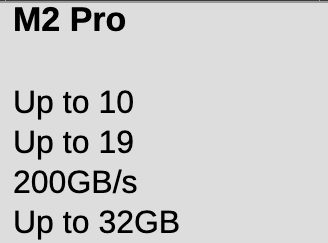Brief Overview of Apple’s Macbook Pro M Pro-Series Processors
M1 Pro To M4 Pro
10/20/2024


When discussing Apple's MacBook Pro lineup, the M-series processors have certainly made an impact, particularly with the launch of the M1 Pro, M2 Pro, M3 Pro, and the upcoming M4 Pro. Each new generation offers improvements in both performance and efficiency, but how do they compare? If you currently own a Macbook Pro with a M1 Pro, M2 Pro, or M3 Pro processor, is upgrading to the M4 Pro a smart move? Let’s explore some details.
Apple M Pro-Series Processors
M1 Pro
Launched in late 2021, the M1 Pro marked a significant advancement from the original M1. It included:
- CPU Cores: Up to 10 cores.
- GPU Cores: Up to 16 cores.
- Memory Bandwidth: 200GB/s.
- Unified Memory: Up to 32GB.
The M1 Pro was tailored for professionals requiring extra power for tasks such as video editing and software development. It delivered remarkable performance and battery life, making it a top choice among creatives.
M2 Pro
The 2 Pro debuted in early 2023, offering moderate enhancements over its predecessor:
- CPU Cores: Similar core count but with architectural refinements.
- GPU Cores: Up to 19 cores.
- Memory Bandwidth: 200GB/s.
- Unified Memory: Up to 32GB.
While users noticed a performance increase (around 15-20% in GPU tasks), many felt it wasn't a revolutionary upgrade compared to the M1 Pro.
M3 Pro
Launched later in 2023, the M3 Pro continued Apple’s pattern of incremental improvements:
- CPU Cores: Up to 12 cores.
- GPU Cores: Up to 18 cores.
- Memory Bandwidth: Reduced to 150GB/s.
- Unified Memory: Up to 36GB.
The M3 Pro provided about a 30% boost in CPU performance and roughly a 40% increase in GPU performance compared to the M1 Pro. However, some users expressed disappointment over the decrease in bandwidth.
M4 Pro
*Updated - Launched Oct. 2024, you can know pre-order the new Macbook Pro with the M4 processor.
- CPU Cores: Up to 14 cores.
- GPU Cores: Up to 20 cores.
- Memory Bandwidth: 273GB/s.
- Unified Memory: Up to 48GB.
The M4 Pro is supposed to be up to 3x faster than the M1 Pro.
Should You Upgrade?
From M1 Pro
If you're using an M1 Pro and your workload has become demanding—especially in graphics-intensive tasks like gaming or video editing—the upgrade to an M4 Pro could be worthwhile. The anticipated performance gains could significantly enhance your productivity and experience. However, if your current setup is meeting your needs, you might want to wait until further reviews come out post-launch.
From M2 Pro
For those on an M2 Pro, the decision is more nuanced. The improvements from M2 to M4 may not be as dramatic as from M1 to M4. If you often push your machine's limits or require better graphics performance, consider upgrading. Otherwise, it might be sensible to stick with your current model for now.
From M3 Pro
If you own an M3 Pro, upgrading might not be necessary unless you have specific needs that align with what the new M4 processor offers. The jump in performance may not justify the cost unless you're looking for very high-end capabilities or features that only come with the latest model.
Conclusion
The evolution from the M1 pro through the upcoming M4 pro shows Apple's commitment to enhancing their MacBook lineup for professionals and creatives alike. Each generation has brought meaningful improvements, but whether you should upgrade depends on your specific use case and how much you rely on your MacBook for demanding tasks.
If your current model meets your needs comfortably, then waiting for user reviews and benchmarks post-M4 launch could be wise. However, if you're feeling constrained by your existing hardware's capabilities, particularly in graphics performance or multitasking efficiency, then jumping on the new tech might just be what you need.
In summary, assess your workload demands against what each processor offers before making that leap!
How Much Pro Do You Need?


